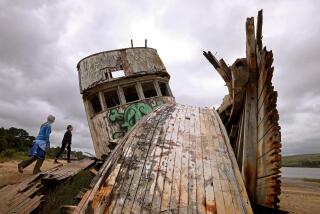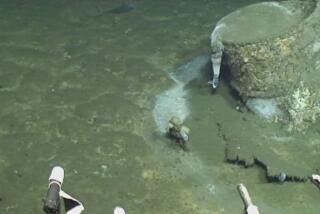Prehistoric Indian Relics Found at Scripps
Researchers at UC San Diego have stumbled upon what they say is a prehistoric Indian site on the campus of Scripps Institution of Oceanography containing an unusual collection of shell fragments and tools apparently used for cooking shellfish.
An archeologist and a marine chemist who excavated the site over the past three weeks said Friday that they believe that La Jollan Indians used the âactivity siteâ 4,400 years ago for cooking shellfish brought up from the ocean below.
âItâs very significant because most of the sites of this period no longer exist,â said Carole Sussman, a visiting lecturer in archeology at UCSD. She said it is one of the last sites in the area remaining intact in its original location.
Discovered During Landscaping
Patricia Masters, a marine chemist at Scripps, said she became curious about the area last year when she noticed stones and shells âeroding outâ during a landscaping project. She asked that the area be cordoned off, then took soil samples that suggested artifacts could be found extending down 20 to 30 centimeters.
Later, shells were radio- and carbon-dated, putting the age of the site as 4,400 years old. Masters described the La Jollans as the major prehistoric people who lived on the Southern California coast from 8,000 to 3,000 years ago.
On June 22, a team began excavating the area, which encompasses about 60 square meters at the north end of the Scripps campus near the Martin Johnson House. Over the next few weeks, they found tools and cobbles and clam, abalone and wavy turban shells.
Though they also found a hearth, they found no traces of pottery nor evidence that anyone had slept or taken shelter there. Masters and Sussman said the cobbles, brought from the beach, may have been used for pounding the clams into a kind of chowder.
Sussman said the objects were probably left in the area over a short period of time--as evidenced by the fact that they were not found at varying depths. She said the site may have been used for âseasonal occupation--coming to the coast to collect marine life.â
However, she and Masters said it remains unclear precisely why the people carried cobble stones and shellfish the long distance up from the beach, what exactly they were doing there and how extensively they occupied the area.
Masters said the site has been mapped and will be photographed in composite. In order to preserve it, the researchers intend to protect it with a cover and replace the earth that has been removed. They are recommending that something ânon-invasive,â like a rock garden, be placed on top.
Ultimately, Masters and Sussman suggested the site be made into an exhibit and used for teaching and research purposes. Masters said it was âextraordinary that (the site) was preserved considering how close it came to being scraped off.â
Masters, who is head of the marine archeology program at Scripps, has been studying âmarine resource procurement patternsâ among prehistoric people. Studying bones for what they reflected about peopleâs diets, she had become interested in a midden, or prehistoric refuse heap, nearby the new site at Scripps.
The âactivity siteâ dig became an offshoot of that.
Jacqueline Parker, a spokeswoman for Scripps, recalled that similar âactivity sitesâ were found a decade ago on the UCSD campus, including one in the chancellorâs backyard.
More to Read
Sign up for Essential California
The most important California stories and recommendations in your inbox every morning.
You may occasionally receive promotional content from the Los Angeles Times.










